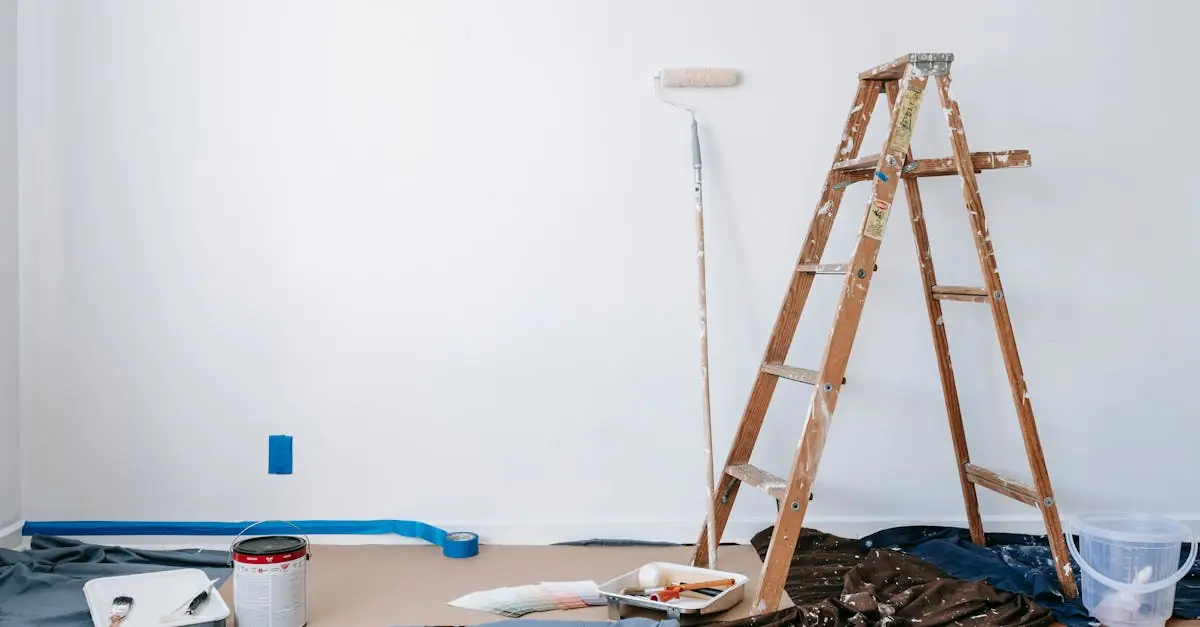Homeowners often find themselves staring at a leaky faucet or a wall that could use a fresh coat of paint and think, “I can’t possibly tackle that myself.” But what if they could? DIY home repairs don’t just save money; they can also unleash a hidden talent for home improvement. With a little guidance and a sprinkle of courage, anyone can transform their space from drab to fab—without calling in the pros.
Picture this: instead of waiting for that overpriced handyman to show up, they could be the hero of their own home. Armed with a toolbox and a few online tutorials, they can conquer everything from squeaky doors to stubborn light fixtures. So why not roll up those sleeves and dive into the world of DIY? It’s time to turn those home repair headaches into a fun adventure. After all, who wouldn’t want bragging rights for fixing a leaky sink?
Table of Contents
ToggleOverview of DIY Home Repairs
DIY home repairs empower homeowners to take control of their living spaces. Embracing these projects fosters self-sufficiency and enhances home value.
Benefits of DIY Home Repairs
Cost savings emerge as a primary benefit, allowing homeowners to avoid expensive contractor fees. Satisfaction increases with each successful project, building confidence in skills. Creativity often flourishes when tackling repairs, leading to personalized home improvements. Learning new techniques makes ongoing maintenance easier, reducing future repair needs. Overall, these advantages encourage a sense of accomplishment that transforms homeownership experiences.
Common DIY Home Repair Projects
Many homeowners start with simple tasks. Fixing leaky faucets often tops the list, providing immediate improvements to plumbing. Painting walls refreshes living spaces and allows for customization. Installing shelves offers additional storage and displays personal items. Repairing drywall not only addresses cosmetic issues but also reinforces structural integrity. Each of these projects presents an opportunity for homeowners to enhance their environment effectively.
Essential Tools for DIY Home Repairs
Equipping a home for DIY repairs requires specific tools that make projects efficient and manageable. Essential tools enable homeowners to tackle various tasks with confidence and ease.
Must-Have Tools for Every Homeowner
Every homeowner needs a basic toolkit. A hammer allows for driving nails and other fasteners, while a set of screwdrivers offers versatility for different screws. Pliers help grasp and manipulate objects, ensuring precision. A measuring tape guarantees accurate dimensions, essential for projects like installing shelves. A utility knife proves invaluable for cutting materials effectively. Additionally, a level ensures surfaces are even, and a drill simplifies creating holes or driving screws. Rounding out this toolkit, a wrench set assists in tightening or loosening nuts and bolts.
Safety Equipment for DIY Projects
Safety equipment plays a critical role in DIY projects. Protective eyewear shields eyes from debris or dust, ensuring a clear line of sight. Ear protection guards against noise from power tools, helping to maintain hearing health. A dust mask filters out harmful particles, making breathing comfortable during projects. For hands, durable gloves safeguard against cuts and abrasions when handling materials. Lastly, a first aid kit provides essential supplies in case of accidents, ensuring quick treatment and peace of mind. Prioritizing safety equipment enhances the DIY experience.
Step-by-Step Guide to Common Repairs
Homeowners can effectively tackle a range of common repairs with the right techniques. Here’s how to approach some of the most frequent projects.
Fixing Leaky Faucets
Identifying the source of a leak is crucial. Often, it requires turning off the water supply first. They should then remove the handle using a screwdriver. After that, they can check the O-ring or washer for wear and tear. Replacing these parts usually resolves the issue. Once replacements are made, reassemble the faucet and turn the water supply back on. Checking for leaks after repairs ensures success.
Patching Drywall Holes
Assessing the size of the hole helps determine the repair method. Small holes can often be filled with spackling compound directly. Larger holes necessitate the use of a patch. To start, they must cut a piece of drywall slightly larger than the hole, then secure it in place. Adding joint compound around the edges allows for seamless blending. After the compound dries, sanding smooth creates a finished look. Painting over the patched area matches it with the surrounding wall.
Replacing Light Fixtures
Safety starts with turning off the power at the circuit breaker when replacing light fixtures. They can approach fixture replacement by removing the old unit’s screws and gently lowering it. Disconnecting the wires follows. Color-coding wire connections assures correct installation. The new fixture wires should connect correspondingly, ensuring a secure fit. Once affixed, restoring power checks for proper function. This method transforms lighting and enhances room ambiance effectively.
Tips for Successful DIY Home Repairs
Successful DIY home repairs rely on careful planning and preparation. Gathering necessary materials and tools beforehand streamlines the repair process. Assessing the project’s complexity helps determine what needs attention first. Sketching out a rough plan can clarify steps and ensure thoroughness during the repair.
Planning and Preparation
Planning leads to effective repairs. Evaluating the scope of the project ensures that all tasks align with your skills. Identifying materials needed, such as specific types of paint or fixtures, minimizes delays. Establishing a realistic timeline allows homeowners to set achievable goals. Meanwhile, researching tutorials or guides can provide useful insights and confidence.
When to Call a Professional
Knowing when to call a professional saves time and prevents unnecessary stress. Complex installations, like electrical work or major plumbing issues, often require expert skills. Structural repairs demand specialized knowledge to ensure safety and compliance with local codes. Recognizing personal limitations helps avoid costly mistakes. Significant renovations frequently benefit from professional guidance, ensuring a smoother process and quality results.
Embracing DIY home repairs opens up a world of possibilities for homeowners. It fosters creativity while enhancing both skills and confidence. Each project completed not only improves the living space but also instills a sense of pride and accomplishment. With the right tools and preparation anyone can tackle repairs effectively and enjoyably.
By taking on these tasks homeowners can save money and increase their home’s value. While some projects may require professional assistance knowing when to call for help is just as important as the repairs themselves. Ultimately the journey of DIY home repairs transforms challenges into rewarding experiences that make a house feel more like a home.





